plein air workshop with Billyo
The biggest question on my mind after packing up and heading out early Friday morning was the swollen, bandaged finger on my painting hand. Two days earlier a wasp had left its fiery sting. A tumble that same day left a scuff on the bottom my right foot, while out walking the dog. Were those incidents omens of warning? Strong irritations seemed intent on discouraging me. Family obligations had prevented me from going other years. Now I was given a green light. Over the next three days I would drive 60 miles to and from Marceline, because I thought I was ready for it. And I found out, I was.
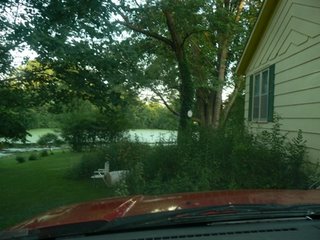 The shortcut I took followed a winding highway 24 east, past planted fields and tree lined creeks, to the village of Brunswick, from which river barges leave with midwest grain. Then north on highway 11, east on Route C, and north again on Route F, which turned into double J before rolling into the rail town of Marceline.
The shortcut I took followed a winding highway 24 east, past planted fields and tree lined creeks, to the village of Brunswick, from which river barges leave with midwest grain. Then north on highway 11, east on Route C, and north again on Route F, which turned into double J before rolling into the rail town of Marceline.
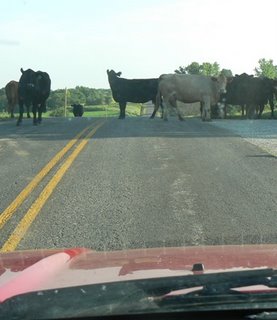 Along the way, I came upon a cluster of cattle who stood in the middle of the road on the crest of a hill.
Along the way, I came upon a cluster of cattle who stood in the middle of the road on the crest of a hill.
 Click triangle to view 30 second clip. When I arrived, the sky was lit, the ground was dry, and there was plenty of time to circle the village and scout out scenes.
Click triangle to view 30 second clip. When I arrived, the sky was lit, the ground was dry, and there was plenty of time to circle the village and scout out scenes. 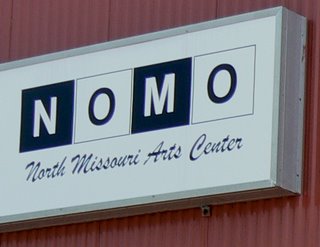 The plein air workshop met at the NOMO gallery on Main Street USA. The same street name used in the American theme park known as Disneyland. Marceline was the home town of Walt Disney. There I was greeted by Billyo O' Donnell, a personable oil painter, from Saint Louis.
The plein air workshop met at the NOMO gallery on Main Street USA. The same street name used in the American theme park known as Disneyland. Marceline was the home town of Walt Disney. There I was greeted by Billyo O' Donnell, a personable oil painter, from Saint Louis.
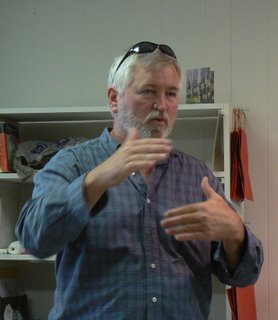 The twenty-five adults were mostly from Missouri, although one college student was visiting from Los Angeles, California. Billyo was an artist who set up challenges for himself to grow his own skills. He once tried to paint the entire St. Louis Symphony Orchestra as it rehearsed. He shared his history as an artist with the group, and talked about his paintings that hung in the NOMO gallery.
The twenty-five adults were mostly from Missouri, although one college student was visiting from Los Angeles, California. Billyo was an artist who set up challenges for himself to grow his own skills. He once tried to paint the entire St. Louis Symphony Orchestra as it rehearsed. He shared his history as an artist with the group, and talked about his paintings that hung in the NOMO gallery.
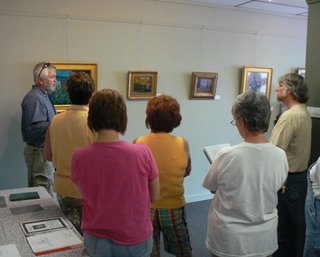 He was not always so well-known. In fact, he was turned down by galleries in his own city simply because he was a local who did landscapes. Back then "Modernism" had been the trend. When he did become well-known he stayed true to his roots. When offered a place of esteem at a prestigious California gallery, he chose to return to Missouri to encourage the arts.
He was not always so well-known. In fact, he was turned down by galleries in his own city simply because he was a local who did landscapes. Back then "Modernism" had been the trend. When he did become well-known he stayed true to his roots. When offered a place of esteem at a prestigious California gallery, he chose to return to Missouri to encourage the arts.
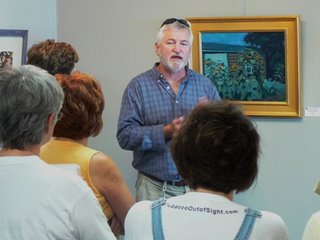 "Problem Solving for the Plein Air Painter" came out his own history with the Marceline art group. Years ago his fellow St. Louis plein air painters drove across the state to take part in an invitational and the next day participated in the village's annual Paint Out. The recent "Art Scene Marceline" had brought 2 demos and 3 workshops to the land of Disney. Grants from the Missouri Arts Council and Missouri Association of Community Arts Agencies (MACAA) had brought someone of his calibier to north central Missouri.
"Problem Solving for the Plein Air Painter" came out his own history with the Marceline art group. Years ago his fellow St. Louis plein air painters drove across the state to take part in an invitational and the next day participated in the village's annual Paint Out. The recent "Art Scene Marceline" had brought 2 demos and 3 workshops to the land of Disney. Grants from the Missouri Arts Council and Missouri Association of Community Arts Agencies (MACAA) had brought someone of his calibier to north central Missouri.
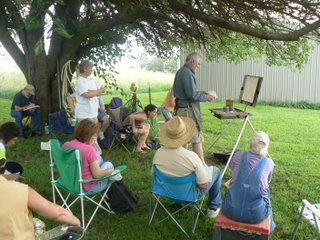 By 9:30 am a string of vehicles headed west on Broadway to the dusty gravel of the Ankeny farm, one mile north west of Marceline. The plan was to set up our easels close in a shaded area where he would give instruction. Later, after we had painted a while, he would give individual pointers which everyone could benefit from. That worked ----- until the rain came.
By 9:30 am a string of vehicles headed west on Broadway to the dusty gravel of the Ankeny farm, one mile north west of Marceline. The plan was to set up our easels close in a shaded area where he would give instruction. Later, after we had painted a while, he would give individual pointers which everyone could benefit from. That worked ----- until the rain came.
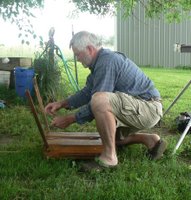
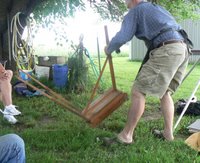
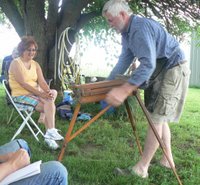 Every easel has its own rhythm, he said. Be patient and find a way that works for you. He demonstrated with a french easel on hand.
Every easel has its own rhythm, he said. Be patient and find a way that works for you. He demonstrated with a french easel on hand.

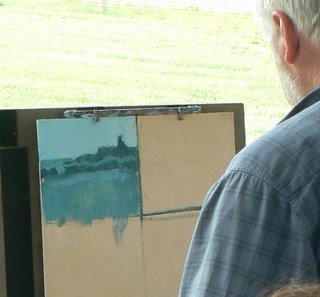 He showed how to block in three masses and use one color to create three values. I found that very helpful. As one student said, "Composition takes the credit, but values do all the work."
He showed how to block in three masses and use one color to create three values. I found that very helpful. As one student said, "Composition takes the credit, but values do all the work."
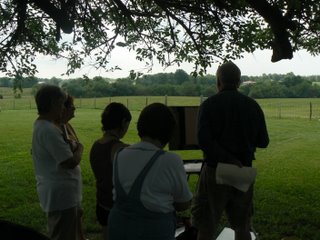 Just after I set up my easel it began to rain. Most of the painters hauled their easels and supplies into the corregated metal buildings nearby. We were able to look out from dry quarters, through the steady rain, to vistas in the distance, from the hill top we were on. I used green Viridian Hue to divide my RayMar canvas board into three masses and create three values. Later (below) I worked additional colors on top.
Just after I set up my easel it began to rain. Most of the painters hauled their easels and supplies into the corregated metal buildings nearby. We were able to look out from dry quarters, through the steady rain, to vistas in the distance, from the hill top we were on. I used green Viridian Hue to divide my RayMar canvas board into three masses and create three values. Later (below) I worked additional colors on top.
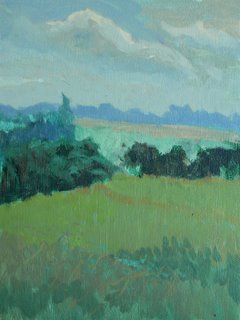
 Billyo recommended to the group that we allow him to make changes on our paintings during the workshop. On mine, he made changes in the mid-ground tree row. He also showed me what foreground grass strokes could be made with a thin long rigger brush. He asked how I could work at all using those "small" brushes. I asked him what he liked about "big" brushes. (I work with a #2 and a #3 flat synthetic blend brush by Utrecht. In contrast, he used a #6 and extra long filbert bristle brushes.) It came down to preference, of course.
Billyo recommended to the group that we allow him to make changes on our paintings during the workshop. On mine, he made changes in the mid-ground tree row. He also showed me what foreground grass strokes could be made with a thin long rigger brush. He asked how I could work at all using those "small" brushes. I asked him what he liked about "big" brushes. (I work with a #2 and a #3 flat synthetic blend brush by Utrecht. In contrast, he used a #6 and extra long filbert bristle brushes.) It came down to preference, of course.
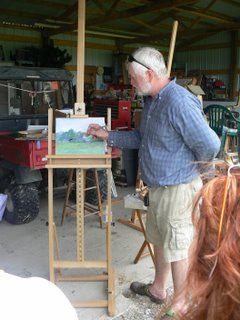 The rain ended, the sun came out, the summer heat was kept in check by pleasant breezes. After we had painted for about an hour, he had us stop, gather around him, and listen as he gave pointers on each of our landscapes.
The rain ended, the sun came out, the summer heat was kept in check by pleasant breezes. After we had painted for about an hour, he had us stop, gather around him, and listen as he gave pointers on each of our landscapes.

Click on triangle for 1 and a half minute clip.

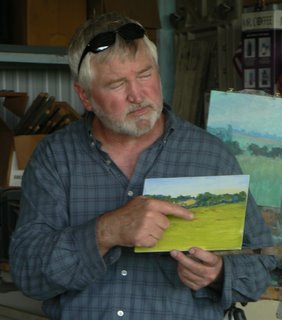
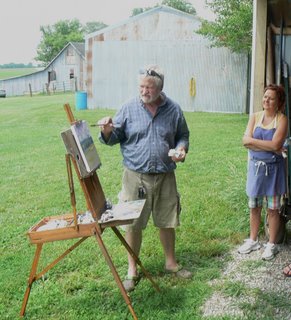
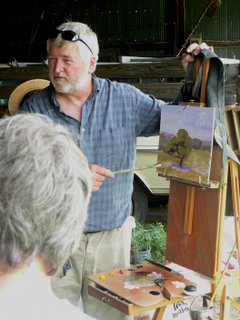 He found more value in letting us work out our own challenges than watching him do a complete demo. I admired him for that. He let us paint for another hour, then we grouped up again and followed him around, while he gave pointers. At lunch time people gathered on the house porch to eat what they brought along. I had to drive into town to buy mine. They were seated on lawn chairs when I returned. The breeze kept the bugs from lighting. After the meal, Chris Ankeny gave us a tour of the century-old farm house. Her art collection included works by Nora Othic and Richard Johnson.
He found more value in letting us work out our own challenges than watching him do a complete demo. I admired him for that. He let us paint for another hour, then we grouped up again and followed him around, while he gave pointers. At lunch time people gathered on the house porch to eat what they brought along. I had to drive into town to buy mine. They were seated on lawn chairs when I returned. The breeze kept the bugs from lighting. After the meal, Chris Ankeny gave us a tour of the century-old farm house. Her art collection included works by Nora Othic and Richard Johnson.
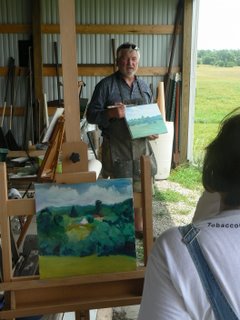
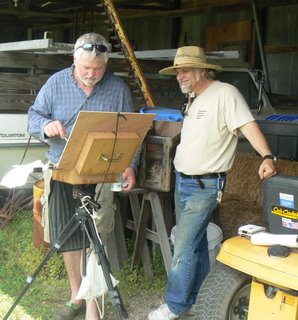 Billyo had us move across the yard, way over by the farm house to start another painting. Amid groans and wishes to complete their first paintings, back and forth traffic began, with arms wrapped around unwieldy easels, backs bent with supply packs. Above us new clouds hid the sun, and stronger wind gusts joined us under a large shade tree. The instructor wanted to see what perspective skills we had. I was not excited about my house painting (below). He told us to not hurry into a scene, but stop, and consider what the painting was going to be about. There were too many possibilities. I could see iris rows, curling vines on a wire fence, dipping branches bobbing up and down, and all kinds house fixtures to size up. When the time came for us to gather round, he began with my 12 by 9 canvas panel.
Billyo had us move across the yard, way over by the farm house to start another painting. Amid groans and wishes to complete their first paintings, back and forth traffic began, with arms wrapped around unwieldy easels, backs bent with supply packs. Above us new clouds hid the sun, and stronger wind gusts joined us under a large shade tree. The instructor wanted to see what perspective skills we had. I was not excited about my house painting (below). He told us to not hurry into a scene, but stop, and consider what the painting was going to be about. There were too many possibilities. I could see iris rows, curling vines on a wire fence, dipping branches bobbing up and down, and all kinds house fixtures to size up. When the time came for us to gather round, he began with my 12 by 9 canvas panel.
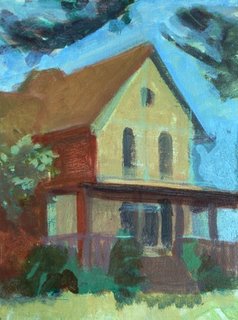 The angle of the house gave the center peak of the roof problems. He went on about eyeballing the sides of the house, finding its true center, and then corrected my peak roof with his brush. My kit was the only "acrylic" one in the bunch. All the others were rightly "oil." It was an oil painting workshop. (I had received permission to work in acrylic, when I registered) So, when he reached over with his brush loaded with mineral spirits, he had caught himself, and re-thought how he would proceed. (You don't mix mineral spirits with water. It could also ruin his paint brush) He used my brushes, mixed colors off my acrylic palette, and rinsed in my water holder. I removed my brass brush holder, because I could see him taking the brush there for rinsing, and then having to halt, and look for the other water container. But he did fine. And he made the points he wanted to teach. Soon, he was on his way to the easel of another student, to make further corrections.
The angle of the house gave the center peak of the roof problems. He went on about eyeballing the sides of the house, finding its true center, and then corrected my peak roof with his brush. My kit was the only "acrylic" one in the bunch. All the others were rightly "oil." It was an oil painting workshop. (I had received permission to work in acrylic, when I registered) So, when he reached over with his brush loaded with mineral spirits, he had caught himself, and re-thought how he would proceed. (You don't mix mineral spirits with water. It could also ruin his paint brush) He used my brushes, mixed colors off my acrylic palette, and rinsed in my water holder. I removed my brass brush holder, because I could see him taking the brush there for rinsing, and then having to halt, and look for the other water container. But he did fine. And he made the points he wanted to teach. Soon, he was on his way to the easel of another student, to make further corrections.
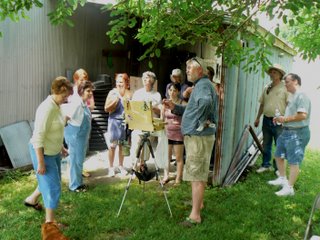 It was quite windy. There were easels being blown over. It was a lot harder to hear him talk. The rushing air filled my ears. There was a lot of standing. My feet were tired. When he had moved on beneath the bending shade tree, I went to pull my lawn chair from my vehicle, returned to the group, sat down and rested within earshot. The workshop wound down at 4 pm. We thanked the instructor for his efforts.
It was quite windy. There were easels being blown over. It was a lot harder to hear him talk. The rushing air filled my ears. There was a lot of standing. My feet were tired. When he had moved on beneath the bending shade tree, I went to pull my lawn chair from my vehicle, returned to the group, sat down and rested within earshot. The workshop wound down at 4 pm. We thanked the instructor for his efforts.
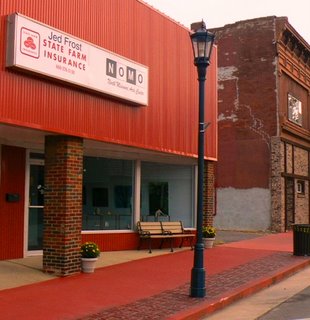 Back in town I swung by gallery. NOMO member Sharon Goddard turned my canvas panels over and stamped the backs. Generally. paint outs do that so that everyone has the same amount of time to produce their paintings. For one hour I drove around the east side looking for places to paint the next day. Joanne Beebee gave me permission to explore the creek bed that wound around her property by Wilson Street. I like when the grass has been mowed right up to the creek. In hot weather like that, I could wear shorts and not worry about stickers. So I walked and stopped and considered the willow trunks, the banks, and then walked and stopped some more. I found a skinny branch, broke it into pieces, and laid them down where I could find them the next day.
Back in town I swung by gallery. NOMO member Sharon Goddard turned my canvas panels over and stamped the backs. Generally. paint outs do that so that everyone has the same amount of time to produce their paintings. For one hour I drove around the east side looking for places to paint the next day. Joanne Beebee gave me permission to explore the creek bed that wound around her property by Wilson Street. I like when the grass has been mowed right up to the creek. In hot weather like that, I could wear shorts and not worry about stickers. So I walked and stopped and considered the willow trunks, the banks, and then walked and stopped some more. I found a skinny branch, broke it into pieces, and laid them down where I could find them the next day.

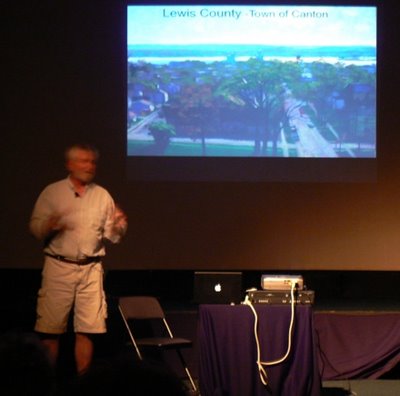 At 6 o'clock Mr. O'Donnell gave a one hour presentation at the Uptown Theater, and shared stories about the people he met during "Painting Missouri". Over a seven year span and 160,000 miles, O' Donnell created an outdoor painting for each of the 114 counties in Missouri and the city of St. Louis. He camped in a tent, no motels, lived out of pocket, gave it his full attention, and later met Karen Glines, who wrote background information about each of the counties in the book.
At 6 o'clock Mr. O'Donnell gave a one hour presentation at the Uptown Theater, and shared stories about the people he met during "Painting Missouri". Over a seven year span and 160,000 miles, O' Donnell created an outdoor painting for each of the 114 counties in Missouri and the city of St. Louis. He camped in a tent, no motels, lived out of pocket, gave it his full attention, and later met Karen Glines, who wrote background information about each of the counties in the book.
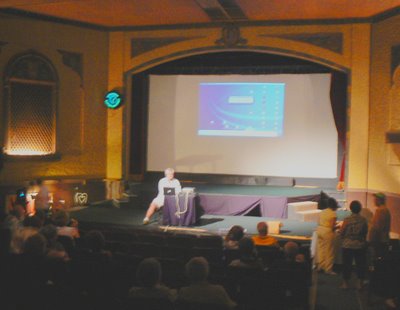
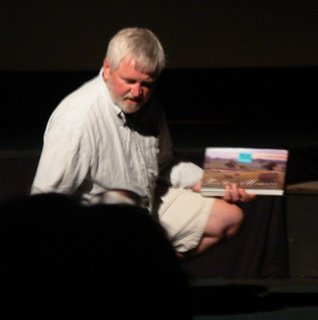
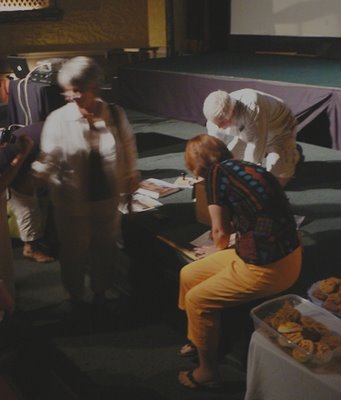 After his talk, he stamped and signed copies of the book. All 3,000 copies had been sold out. A second edition was being planned, it was announced.
After his talk, he stamped and signed copies of the book. All 3,000 copies had been sold out. A second edition was being planned, it was announced.
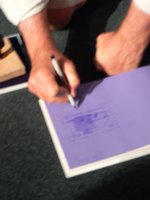
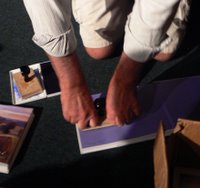 He announced the entire collection of 115 paintings was going to be on display at the Boone County Historical Museum in Columbia, Missouri from June to August. And then it would be at the Missouri State University Art & Design gallery in Springfield, Missouri during September.
He announced the entire collection of 115 paintings was going to be on display at the Boone County Historical Museum in Columbia, Missouri from June to August. And then it would be at the Missouri State University Art & Design gallery in Springfield, Missouri during September.
At 7:30 pm I attended the Marceline Paint Out reception across the street at Darrell Gardner's studio. Tables with grapes, ham wraps, cookies, wine, and air-conditioning. Ahhh. Walls lined with large framed paintings of the Grand Canyon by Gardner after the Swedish-American Birger Sandzen. Darlene Gardner asked about my blistered finger. Yes, I was able to bend it. No, it had not kept me from painting. The demands of the irritation had become less. Almost as if it was saying to me, "See you later. I have done my part. Bye, bye." Billyo and Peggyo had their own sore muscles from the trip up. They had been rear ended in traffic, and he said his neck was aching from that. Inspite of that he gave the workshop. Maybe that was what those irritations were about. Pressing on. With a full day behind me, I headed home.
Click on triangle for 1 and a half minute clip.
At 7:30 pm I attended the Marceline Paint Out reception across the street at Darrell Gardner's studio. Tables with grapes, ham wraps, cookies, wine, and air-conditioning. Ahhh. Walls lined with large framed paintings of the Grand Canyon by Gardner after the Swedish-American Birger Sandzen. Darlene Gardner asked about my blistered finger. Yes, I was able to bend it. No, it had not kept me from painting. The demands of the irritation had become less. Almost as if it was saying to me, "See you later. I have done my part. Bye, bye." Billyo and Peggyo had their own sore muscles from the trip up. They had been rear ended in traffic, and he said his neck was aching from that. Inspite of that he gave the workshop. Maybe that was what those irritations were about. Pressing on. With a full day behind me, I headed home.
Labels: Billyo O'Donnell, Birger Sandzen, Darrell Gardner, Karl Marxhausen paintings, Marceline, NOMO, plein air, RayMar, Utrecht, video

